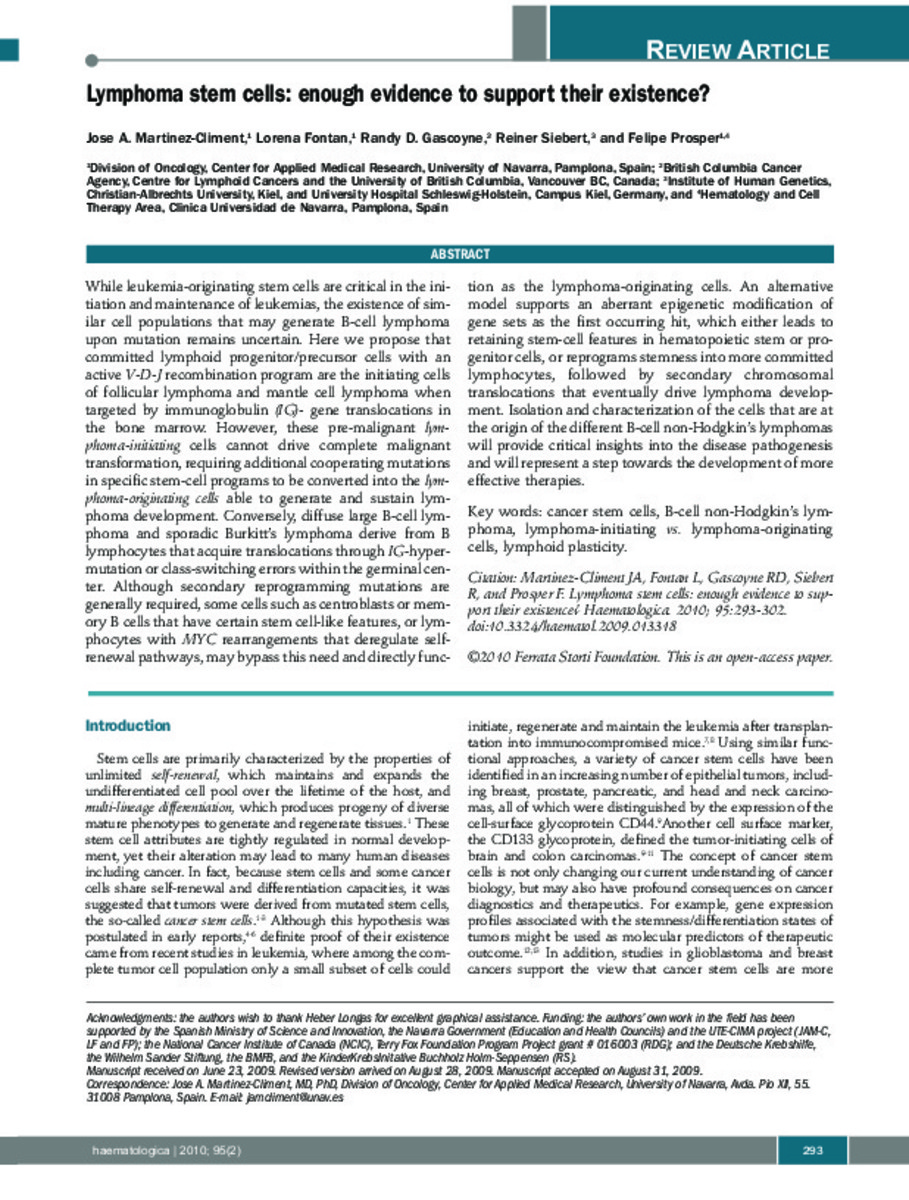Full metadata record
| DC Field | Value | Language |
|---|---|---|
| dc.creator | Martinez-Climent, J.A. (José Ángel) | - |
| dc.creator | Fontan, L. (Lorena) | - |
| dc.creator | Gascoyne, R.D (R. D.) | - |
| dc.creator | Siebert, R. (Reiner) | - |
| dc.creator | Prosper-Cardoso, F. (Felipe) | - |
| dc.date.accessioned | 2011-05-06T14:16:55Z | - |
| dc.date.available | 2011-05-06T14:16:55Z | - |
| dc.date.issued | 2010 | - |
| dc.identifier.citation | Martínez-Climent J. A., Fontan L., Gascoyne R. D., Siebert R. et al... Lymphoma stem cells: enough evidence to support their existence? Haematologica 2010; 95(2): 293-302. | es_ES |
| dc.identifier.issn | 0390-6078 | - |
| dc.identifier.uri | https://hdl.handle.net/10171/17885 | - |
| dc.description.abstract | While leukemia-originating stem cells are critical in the initiation and maintenance of leukemias, the existence of similar cell populations that may generate B-cell lymphoma upon mutation remains uncertain. Here we propose that committed lymphoid progenitor/precursor cells with an active V-D-J recombination program are the initiating cells of follicular lymphoma and mantle cell lymphoma when targeted by immunoglobulin (IG)- gene translocations in the bone marrow. However, these pre-malignant lymphoma-initiating cells cannot drive complete malignant transformation, requiring additional cooperating mutations in specific stem-cell programs to be converted into the lymphoma-originating cells able to generate and sustain lymphoma development. Conversely, diffuse large B-cell lymphoma and sporadic Burkitt’s lymphoma derive from B lymphocytes that acquire translocations through IG-hyper-mutation or class-switching errors within the germinal center. Although secondary reprogramming mutations are generally required, some cells such as centroblasts or memory B cells that have certain stem cell-like features, or lymphocytes with MYC rearrangements that deregulate self-renewal pathways, may bypass this need and directly function as the lymphoma-originating cells. An alternative model supports an aberrant epigenetic modification of gene sets as the first occurring hit, which either leads to retaining stem-cell features in hematopoietic stem or progenitor cells, or reprograms stemness into more committed lymphocytes, followed by secondary chromosomal translocations that eventually drive lymphoma development. Isolation and characterization of the cells that are at the origin of the different B-cell non-Hodgkin’s lymphomas will provide critical insights into the disease pathogenesis and will represent a step towards the development of more effective therapies. | es_ES |
| dc.language.iso | eng | es_ES |
| dc.publisher | Pensiero Scientifico / Ferrata Storti Foundation | es_ES |
| dc.rights | info:eu-repo/semantics/openAccess | es_ES |
| dc.subject | Cancer stem cells | es_ES |
| dc.subject | B-cell non-Hodgkin’s lymphoma | es_ES |
| dc.subject | Lymphoma-initiating cells | es_ES |
| dc.subject | Lymphoma-originating cells | es_ES |
| dc.subject | Lymphoid plasticity | es_ES |
| dc.title | Lymphoma stem cells: enough evidence to support their existence? | es_ES |
| dc.type | info:eu-repo/semantics/article | es_ES |
| dc.relation.publisherversion | http://www.haematologica.org/cgi/content/abstract/95/2/293 | es_ES |
Files in This Item:
Statistics and impact
Items in Dadun are protected by copyright, with all rights reserved, unless otherwise indicated.






